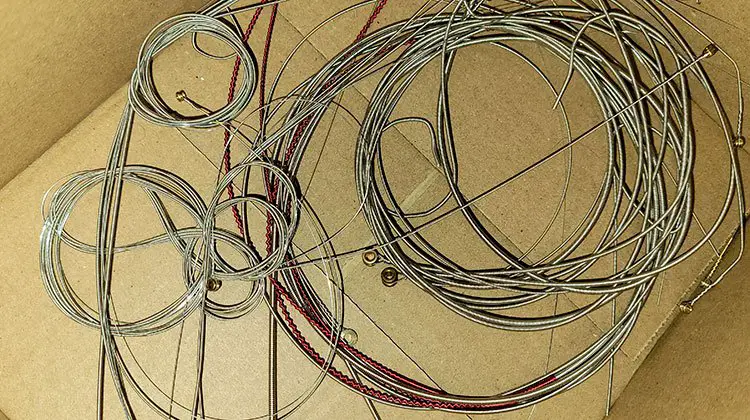Strings are the one thing that unites all guitar players. We all have our preferences for brands, gauges, and the material they are made of. But, all of us struggle with what to do once we’ve worn them out. Do they go in the garbage? Can we somehow recycle them or repurpose them? If you’re looking for ways to recycle or repurpose your guitar strings this post will offer some options.

What Are Guitar Strings Made Of?
A significant component of guitar strings is stainless steel. However, there are some other commonly used materials for guitar strings:
- Nickel and Steel: Most commonly used in electric guitars. They are great for rhythm while also providing warmth to the sound. Thicker strings are generally plated in nickel, making them hard to separate manually and recycle.
- Brass and Bronze: Steel-stringed acoustic guitars are generally plated with brass or bronze. Same as nickel, although not entirely impossible, salvaging these metals can be difficult.
- Nylon: Classical guitars use nylon strings to achieve a mellow and warm sound. In terms of sustainability, nylon often ends up in landfills and is not repurposed.
D’Addario Doing Their Bit
To mark Earth Day, in 2016, global string giant D’Addario launched an ambitious guitar string recycling program called Playback. They partnered with an international upcycling and recycling company Terrabyte. Whose objective is to minimize carbon footprint by repurposing waste into innovative new products.
For individual consumers, the way this works is that you sign up for Player’s Circle on their website. Once you have about 2 pounds worth of strings, you can print out a label and ship it to them. But that is not all. They offer you points on your shipments which you can then redeem for new gear and merchandise of your choice.
Additionally, D’Addario also offers this facility for retails shops, educational institutions, and any wholesale consumer or seller of strings. These are their String Recycling Centers‘ While they provide retailers with bins where people can drop off their used strings off. The retailers are responsible for filling up the bins and shipping them to them in bulk quantities. If you choose to sign up for this, they include your location on their map so others can find you easily.
In case you were wondering, yes, you can drop them off at your nearest Guitar Center too.
In 2019, Martin Guitar announced their partnership with the Playback program stating their commitment to sustainable practices and environmental stewardship.
D’Addario explains that potentially 1.5 million pounds of strings end up in landfills each year since municipal programs cannot recycle them. By 2021, their goal is to recycle 8 million strings, and so far, they are at an impressive 6 million.
Outside of the US, they have partnered with Warchal Strings in Slovakia and Blue Music Tools in France, which had launched similar programs in 2012 and 2009.
Caring For Your Strings
With limited options to recycle old strings, the best thing to do is take care of them, so you do not have to change them as much. Humidity is a critical component of string damage. When you allow moisture to collect on the fretboard, the strings will rust a lot faster.
Even if you live in a dry climate, sweat can be a reason for your strings to get dirty. The easiest thing to do is regularly wipe down your guitar fretboard and body and prevent it from collecting dirt and dust.
Another way to protect your strings, especially electric ones, is to use a dedicated fretboard cleaning oil that will help remove debris from them.
You can keep silica gel or dehumidifiers designed explicitly for guitars in your guitar case in humid places. Decreasing the humidity will prevent moisture from ruining your strings and keep them fresh-sounding for a long time.
DIY Projects
Did you know that many famous musicians like to wear bracelets made out of their old strings? Instead of throwing them away, you can turn them into jewelry or hand them over to someone who likes to make necklaces, rings, bracelets, etc., out of what you might consider garbage. Not only is this good for the environment, but it also makes for personal and handcrafted jewelry that you can proudly flaunt.
Another great idea is to hang pictures and frames using old strings. Unlike cotton or plastic, guitar strings are sturdy and will not break as easily.
There is nothing more satisfying than creating art. If you have an artsy side to you, you can always incorporate old strings into whatever you create. Turn your strings into a picture of a guitar! Creating art with used strings can be a fun project when you want to take some time out and indulge in a hobby.
Trust your creativity and create something that is practical. It will give you the satisfaction of knowing it is repurposed from materials that would otherwise end up in a landfill.
Change
With climate change being something that terrifies most of us to the extent of keeping us awake at night Most guitar players often do not realize the kind of carbon footprint they are leaving behind.
A little bit goes a long way. Whether you actively send your strings to a recycling program or devise your own ingenious method, the important thing is to be conscious of your choices. After all, music exists only on earth. The more we can take care of it, the longer it will continue to thrive and make it a better place for future generations.